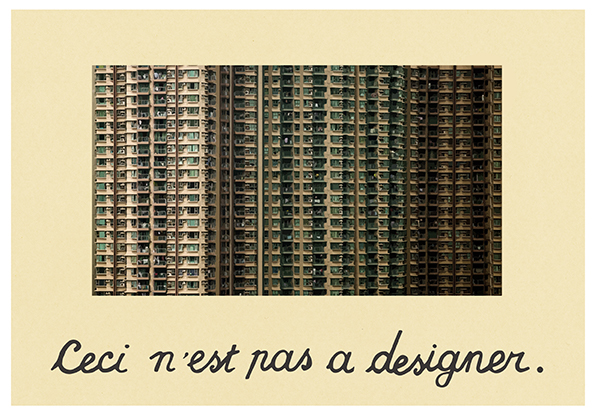
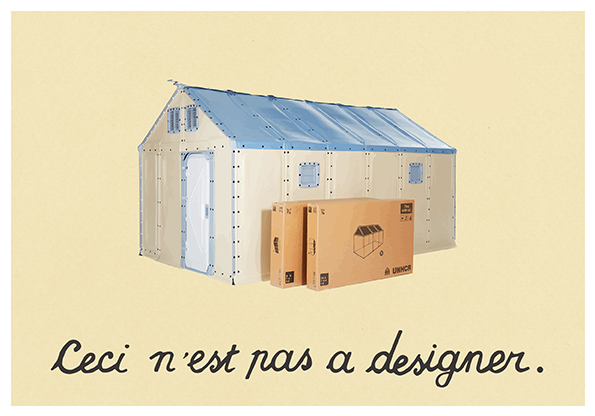
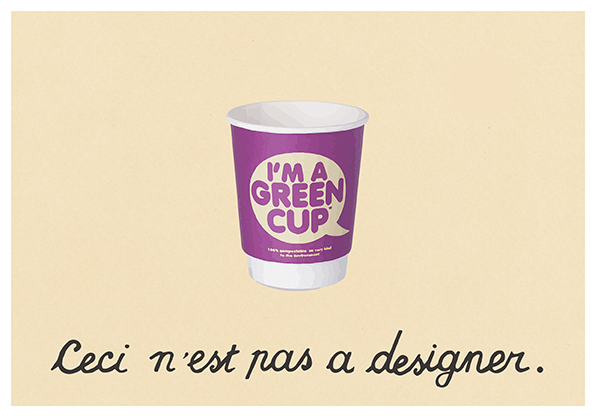
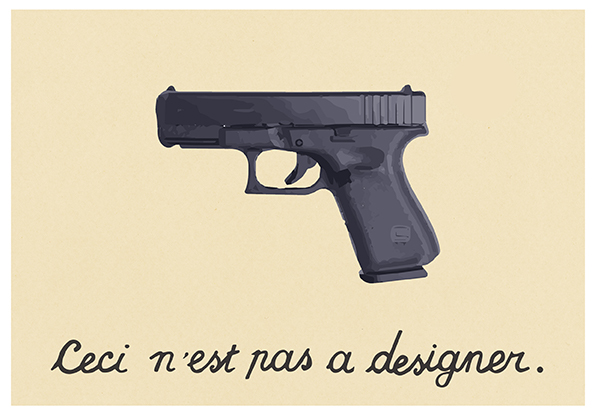
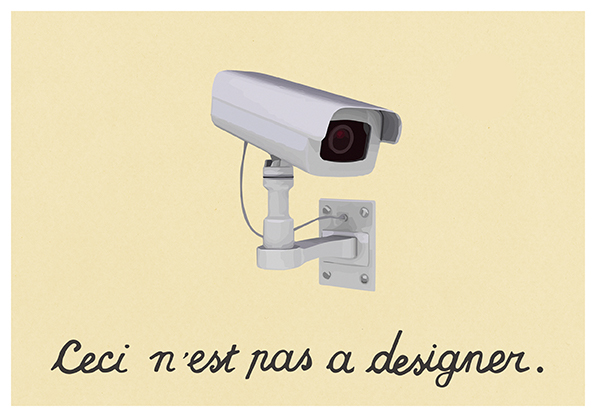
english (translation) // Years ago, in a family home, the Magritte piece “Ceci n’est pas une pipe” is hanging on the wall facing the window. A kid, through unexpert youthful eyes, stares at it and finds that there is something wrong with it. The pipe looks like a pipe is supposed to be, yet it is not? Definitely controversial! Could the representation of what one believes is real be concealing an ontological identity unknown to us?
With time and reflection, the kid will grow to love the piece, once unraveling the surrealist trick of the trompe l’oeil, and soon turn into a young adult who recognises that the relationship between reality and truth is frail, because it is built on rules and superstructures that are human, thus limited, flawed and subjective.
Years pass by and the young adult decides to become a designer, for reasons that have little to do with surrealism and much to do with the kid’s curiosity and passion in understanding people’s needs and giving shape/form to them. Enrolled into a renowned design school, the kid will study the rules of the form, alongside functionality. Moving forward in studies, being lulled by the usual routine, the designer will forget the surrealist lesson which would have helped in noticing how functionality also depends on a selective type of representation of reality and truth. But the young designer seems too busy for reflections; learning softwares and “the art” of digital representation.
One day the young adult finds a job and everyone offers congratulations because “the market is tough and the crisis is severe”, so the kid thinks “this is the dream!”, believing achievements could change the world. So the designer starts a new job, and hunches over a laptop, drawing a reality where buildings are geometric shapes, objects are an ensemble of polylines, space is a distant top view and digital perspectives are crafted to cheat the client into thinking that the purchased product will fit perfectly in reality, because it’s always sunny in Photoshop. Everyday seems like a new day and comes with new shapes, new objects, new polylines; each one of these appearing brighter and brighter, although under the same Adobe-sky.
Time brought money and fame to the kid, who’s now a successful adult, and it’s the first time that a big project assumes form in real life. It’s the inauguration day and everyone is excited to see what the designer has created. A heavy piece of cloth conceals the project from the eyes of those present. Once the mystery underneath the cloth is unraveled the crowd burst into a thunderous applause, cheering the fame of the designer. A beautiful, perfectly executed, digital object shines in the light of a sunny day.
The designer feels proud that the design is receiving such loud consensus from the public opinion, and smiles. But then stares at the design object and thinks that there is something wrong with it. What is it though? The thickness of the polylines is good, the colours are good, the plans are good, so it means that the form is correct! Then the designer understands; it’s the sun! Yet it did not look like this on Photoshop…was there a problem with the print? And then, as if that wasn’t enough, the designer looks around and all the other products of design look wrong as well! The designer, shaking the head, says; “there must be something wrong with the filters”.
Dizzy and dazzled, the designer goes home, sits, and this time, smoking a pipe, reflects.
italian (original) // Anni fa, in una casa di famiglia, il quadro di Magritte “Ceci n’est pas une pipe” è appeso alla parete di fronte alla finestra. L* bambin*, attraverso gli occhi inesperti della giovinezza, fissa il quadro e trova che ci sia qualcosa di sbagliato. La pipa appare come una pipa dovrebbe essere, eppure non lo è? Decisamente controverso! Può la rappresentazione di ciò che crediamo reale celare un’identità ontologica a noi sconosciuta?
Nel tempo, riflettendo, l*l bambin* imparerà ad amare il quadro, una volta scoperto il trucco surrealista del trompe l’oeil, diventando presto un* giovane adult* che riconosce la fragilità della relazione tra realtà e verità, poiché fondata su regole e sovrastrutture di matrice umana, dunque limitate, imperfette e soggettive.
Gli anni passano e l* giovane adult* decide che vuole diventare un* designer, per ragioni che poco hanno a che fare con il surrealismo e molto con la curiosità e passione del* bambin* nel comprendere i bisogni delle persone ed a questi dare forma. Inscritt*si ad una rinomata scuola di design, studierà dunque le regole della forma, assieme alle sue funzionalità. Andando avanti negli studi, facendosi cullare dal solito tran tran, dimenticherà la lezione surrealista che l* avrebbe aiutato a notare quanto anche la funzionalità dipenda dalla rappresentazione selettiva di un certo tipo di realtà e verità. Ma l* giovane designer sembra essere troppo occupat* per le riflessioni mentre impara ad usare i programmi di disegno e “l’arte” della rappresentazione digitale.
Un giorno l* giovane adult* trova lavoro e tutti si congratulano perché “il mercato è duro e la crisi è severa”, così l* bambin* pensa “questo è il sogno!”, illudendosi che il proprio successo possa cambiare il mondo. Dunque l* designer comincia il nuovo lavoro e si piega sul computer, disegnando una realtà in cui gli edifici sono forme geometriche, gli oggetti sono un insieme di polilinee, lo spazio è una vista lontana dall’alto e le prospettive digitali sono fabbricate per ingannare il cliente che il prodotto comprato si inserirà perfettamente nella realtà, perché è sempre bel tempo su Photoshop. Ogni giorno sembra un nuovo giorno che arriva con nuove forme, nuovi oggetti, nuove polilinee; ognuno di questi appare sempre più luminoso, seppur sotto lo stesso cielo di Adobe.
Il tempo ha portato soldi e fama al* bambin*, che ora è un* adult* di successo, ed è all’improvviso la prima volta che un grande progetto acquisisce forma nella vita reale. E’ il giorno dell’inaugurazione e tutti sono trepidanti di vedere ciò che l* designer ha creato. Una stoffa pesante cela il progetto dalla vista dei presenti. Una volta svelato il mistero nascosto sotto la stoffa la folla scoppia in un applauso fragoroso, esultando per la fama del* designer. Un bellissimo, perfettamente realizzato, oggetto digitale brilla nella luce della giornata assolata.
L*l designer si sente fier* che il design stia ricevendo così forti consensi da parte dell’opinione pubblica, e sorride. Poi però fissa l’oggetto di design e trova che ci sia qualcosa di sbagliato. Che cosa però? Lo spessore delle polilinee va bene, i colori vanno bene, le piante vanno bene, dunque significa che la forma è corretta! Poi capisce; è il sole! Eppure non appariva così su Photoshop… che ci sia stato un problema con la stampa? E poi, come se non fosse abbastanza, si guarda attorno e anche tutti gli altri prodotti di design hanno qualcosa di sbagliato! L* designer, scuotendo la testa, dice; “ci dev’essere per forza qualcosa di sbagliato coi filtri”.
Stordit* e abbagliat*, l* designer torna a casa, si siede e questa volta, fumando una pipa, riflette.
author
a projektado members’ contribution.
first published for projektado magazine issue 0: why discuss design today? / january 2021
